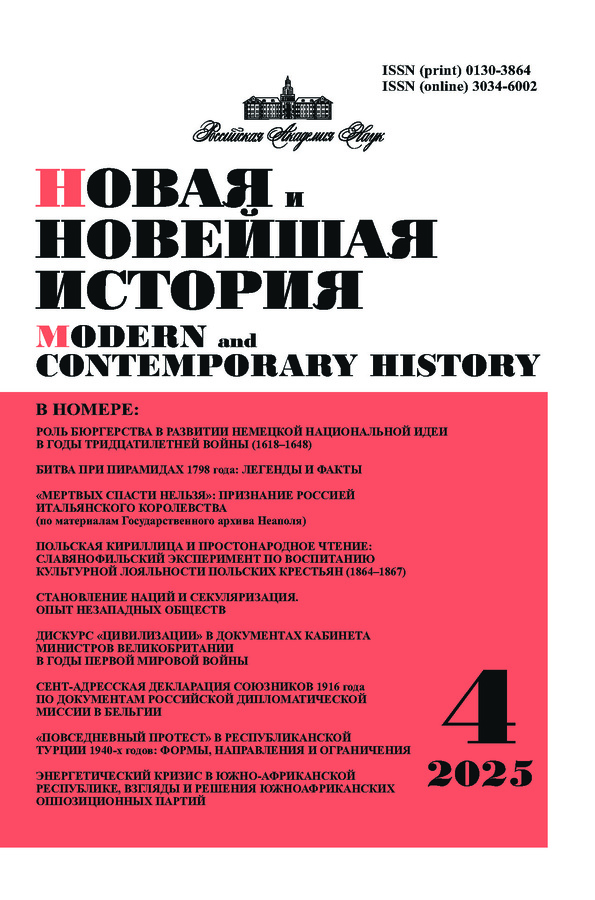The Soviet Diplomatic Catastrophe in Beijing on April 6, 1927
- Authors: Shubin A.V.1
-
Affiliations:
- Institute of World History, Russian Academy of Sciences
- Issue: No 4 (2025)
- Pages: 146-157
- Section: 20th century
- URL: https://rjdentistry.com/0130-3864/article/view/691865
- DOI: https://doi.org/10.31857/S0130386425040105
- ID: 691865
Cite item
Abstract
This article examines the events of 6 April 1927 in Beijing, when Chinese security forces raided premises associated with the Soviet diplomatic mission, conducting arrests and seizures. In Soviet historiography, this episode was long portrayed as a flagrant breach of international law and a manifestation of an imperialist conspiracy against the USSR. This interpretation – framing the incident as an “attack on the embassy” – has persisted in much of Russian historical writing. However, the operation was carried out under the authority of the Beijing government, led by Wellington Koo and Zhang Zuolin, on premises that, contrary to Soviet assumptions, did not enjoy diplomatic extraterritoriality. The Soviet diplomats’ lack of awareness regarding the legal status of these properties resulted in serious consequences: key Soviet military and intelligence personnel, as well as Chinese Communists, were exposed to a coordinated strike by the Chinese authorities. The search uncovered extensive documentary evidence of Soviet subversive activities in China, including the operations of the Comintern and the Chinese Communist Party (CCP), support for Kuomintang General Feng Yuxiang – then in opposition to the Beijing regime – funding of anti-government activities, and covert intelligence work by Soviet advisers. Among the most significant revelations was the direct involvement of CCP leader Li Dazhao in armed resistance, leading to his execution alongside several associates. The fallout from the raid significantly weakened Soviet and Communist influence in northern China. While the episode has often been labelled an attack on a diplomatic mission, it is more accurately described as the seizure of Soviet and Communist institutions operating without diplomatic immunity.
About the authors
A. V. Shubin
Institute of World History, Russian Academy of Sciences
Email: historian905@gmail.com
Moscow, Russia
References
- Ajrapetov O.R. Vneshnyaya politika Sovetskoj Rossii i SSSR v 1920–1939 godah i istoki Vtoroj mirovoj vojny [The foreign policy of Soviet Russia and the USSR in 1920–1939 and the origins of the Second World War]. Moskva, 2020. (In Russ.)
- Alekseev M.N. Sovetskaya voennaya razvedka v Kitae i hronika “kitajskoj smuty” [Soviet military intelligence in China and the chronicle of the “Chinese Troubles”] (1922–1929). Moskva, 2010. (In Russ.)
- Dokumenty vneshnej politiki SSSR. T. 10. 1 yanvarya – 31 dekabrya 1927 g. [Documents of the USSR’s foreign policy. Vol. 10. January 1 – December 31, 1927]. Moskva, 1965. (In Russ.)
- Dolg i otvaga. Vospominaniya o dipkur’erah [Duty and courage. Memories of diplomatic couriers]. Moskva, 1988. (In Russ.)
- Istoriya diplomatii [History of Diplomacy]. T. 3. Moskva; Leningrad, 1945. (In Russ.)
- Mamaeva N.L. Komintern i Gom in’dan [The Comintern and the Kuomintang]. 1919–1929. Moskva, 1999. (In Russ.)
- Novejshaya istoriya Kitaya [The modern history of China]. 1917–1927. Moskva, 1983. (In Russ.)
- Sergeev E.Yu. Obmanchivyj rassvet. Sovetskij Soyuz i Velikobritaniya v 1925–1932 gg. [Deceptive dawn. The Soviet Union and Great Britain in 1925–1932]. Moskva, 2024. (In Russ.)
- Shubin A.V. Vozhdi i zagovorshchiki. Politicheskaya bor’ba v SSSR v 20–30-kh godakh [Leaders and conspirators. The political struggle in the USSR in the 20–30s]. Moskva, 2004. (In Russ.)
- VKP(b), Komintern i nacional‘no-osvoboditel‘noe dvizhenie v Kitae. Dokumenty [The CPSU(b), the Comintern and the National liberation movement in China. Documents]. T. 2. Ch. 2. Moskva, 1996. (In Russ.)
- Clements J. Makers of the Modern World: Wellington Koo. London, 2008.
- Craft S.G. Wellington Koo and the Emergence of Modern China. Lexington, 2014.
Supplementary files










